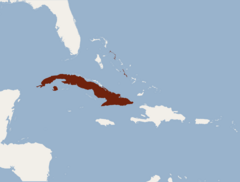Lejkousznik uroczy
Lejkousznik uroczy[7] (Nyctiellus lepidus) – gatunek ssaka z rodziny lejkouchowatych (Natalidae).
| Nyctiellus lepidus[1] | |||
| (Gervais, 1837) | |||
 Nietoperz lejkousznik uroczy - Nyctiellus lepidus, Kuba. | |||
| Systematyka | |||
| Domena | |||
|---|---|---|---|
| Królestwo | |||
| Typ | |||
| Podtyp | |||
| Gromada | |||
| Podgromada | |||
| Infragromada | |||
| Rząd | |||
| Podrząd | |||
| Nadrodzina | |||
| Rodzina | |||
| Rodzaj |
Nyctiellus | ||
| Gatunek |
lejkousznik uroczy | ||
| Synonimy | |||
| |||
| Kategoria zagrożenia (CKGZ)[6] | |||
 | |||
| Zasięg występowania | |||
 Zasięg występowania lejkousznika uroczego | |||
Taksonomia edytuj
Gatunek po raz pierwszy zgodnie z zasadami nazewnictwa binominalnego opisał w 1837 roku francuski zoolog Paul Gervais nadając mu nazwę Vespertilio lepidus[4]. Holotyp pochodził z Kuby[8]. Jedyny przedstawiciel rodzaju lejkousznik[7] (Nyctiellus) który nazwał w 1855 roku również Paul Gervais[2].
Autorzy Illustrated Checklist of the Mammals of the World uznają ten gatunek za monotypowy[9].
Etymologia edytuj
Zasięg występowania edytuj
Lejkousznik uroczy występuje w Kubie (w tym Isla de la Juventud) i Bahamach (wyspy Eleuthera, Cat, Great Exuma, Little Exuma i Long)[9]. Jedyne znane wymarłe populacje znajdowały się na wyspach w archipelagu Bahamów: Andros i New Providence[6][12][13].
Morfologia edytuj
Długość ucha 10–16 mm, długość przedramienia samic 28,1–31 mm, samców 26,6–31 mm; masa ciała samic 2,3–2,7 g, samców 1,9–2,7 g[14].
Uwagi edytuj
- ↑ Niepoprawna późniejsza pisownia Nyctiellus Gervais, 1855.
Przypisy edytuj
- ↑ Nyctiellus lepidus, [w:] Integrated Taxonomic Information System (ang.).
- ↑ a b P. Gervais: Mammifères. W: F. de Castelnau: Animaux nouveaux ou rares recueillis pendant l’expédition dans les parties centrales de l’Amérique du Sud, de Rio de Janeiro a Lima, et de Lima au Para; exécutée par ordre du gouvernement français pendant les années 1843 a 1847, sous la direction du comte Francis de Castelnau. Paris: P. Bertrand, 1855, s. 84. (fr.).
- ↑ J.E. Gray. Synopsis of the Genera of Vespertilionidæ and Noctilionidæ. „The Annals and Magazine of Natural History”. Third series. 17 (98), s. 91, 1866. (ang.).
- ↑ a b P. Gervais. Sur les animaux mamifères des Antilles. „L’Institut”. 5 (218), s. 253, 1837. (fr.).
- ↑ J.C. Gundlach. Beschreibung von vier auf Cuba gefangenen Fledermäusen. „Archiv für Naturgeschichte”. 6 (1), s. 357, 1840. (niem.).
- ↑ a b L. Davalos & C. Mancina, Nyctiellus lepidus, [w:] The IUCN Red List of Threatened Species 2016, wersja 2021-3 [dostęp 2022-07-14] (ang.).
- ↑ a b Systematyka i nazwy polskie za: W. Cichocki, A. Ważna, J. Cichocki, E. Rajska-Jurgiel, A. Jasiński, W. Bogdanowicz: Polskie nazewnictwo ssaków świata. Warszawa: Muzeum i Instytut Zoologii PAN, 2015, s. 110. ISBN 978-83-88147-15-9. (pol. • ang.).
- ↑ D.E. Wilson & D.M. Reeder (redaktorzy): Species Nyctiellus lepidus. [w:] Mammal Species of the World. A Taxonomic and Geographic Reference (Wyd. 3) [on-line]. Johns Hopkins University Press, 2005. [dostęp 2022-07-14].
- ↑ a b C.J. Burgin, D.E. Wilson, R.A. Mittermeier, A.B. Rylands, T.E. Lacher & W. Sechrest: Illustrated Checklist of the Mammals of the World. Cz. 2: Eulipotyphla to Carnivora. Barcelona: Lynx Edicions, 2020, s. 190. ISBN 978-84-16728-35-0. (ang.).
- ↑ T.S. Palmer. Index Generum Mammalium: a List of the Genera and Families of Mammals. „North American Fauna”. 23, s. 466, 1904. (ang.).
- ↑ lepidus, [w:] The Key to Scientific Names, J.A. Jobling (red.), [w:] Birds of the World, S.M. Billerman et al. (red.), Cornell Lab of Ornithology, Ithaca [dostęp 2022-07-14] (ang.).
- ↑ A. Tejedor, Systematics of funnel-eared bats (Chiroptera: Natalidae). Bulletin of the American Museum of Natural History 353, 2011, s. 1-140 (ang.).
- ↑ Fossil Chiroptera and Rodentia from the Bahamas, and the historical biogeography of the Bahamian mammal fauna.. W: G.S. Morgan, C.A. Woods (pod redakcją): Biogeography of the West Indies: in Past, present, and future. Gainesville, Floryda, USA.: Sandhill Crane Press, 1989, s. 685-740. (ang.).
- ↑ A. Tejedor: Family Natalidae (Funnel-eared Bats). W: D.E. Wilson & R.A. Mittermeier (redaktozry): Handbook of the Mammals of the World. Cz. 9: Bats. Barcelona: Lynx Edicions, 2019, s. 591. ISBN 978-84-16728-19-0. (ang.).